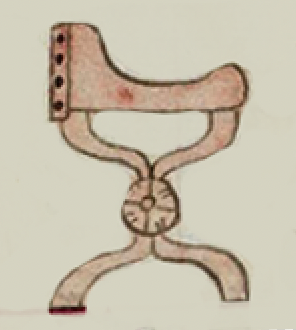netlaliloni (CST20)
This painting of the simplex glyph for the term netlaliloni (chair) shows a European curule chair in profile, facing toward the viewer’s right. The structure of the chair has an X-shape. The entire chair is painted a pinkish color.
Stephanie Wood
The curule chair originates in Europe. In New Spain, colonial authorities typically sat on these chairs. But the Indigenous elite was acquiring such symbols of authority and power, too. The text mentioning what was a purchase of six curule chairs indicates that they had a value of 2 pesos each, and they were apparently made locally. See below for examples of Spanish colonial authorities seated on curule chairs. For more on the Codex Sierra, see Kevin Terraciano’s study (2021).
Stephanie Wood
1550–1564
Jeff Haskett-Wood
sillas curules

netlaliloni, a seat, a chair, https://nahuatl.wired-humanities.org/content/netlaliloni
silla curul
Stephanie Wood
Códice Sierra-Texupan, plate 20, page dated 1558. Origin: Santa Catalina Texupan, Mixteca Alta, State of Oaxaca. Kevin Terraciano has published an outstanding study of this manuscript (Codex Sierra, 2021), and in his book he refers to alphabetic and “pictorial” writing, not hieroglyphic writing. We are still counting some of the imagery from this source as hieroglyphic writing, but we are also including examples of “iconography” where the images verge on European style illustrations or scenes showing activities. We have this iconography category so that such images can be fruitfully compared with hieroglyphs. Hieroglyphic writing was evolving as a result of the influence of European illustrations, and even alphabetic writing impacted it.
https://bidilaf.buap.mx/objeto.xql?id=48281&busqueda=Texupan&action=search
The Biblioteca Digital Lafragua of the Biblioteca Histórica José María Lafragua in Puebla, Mexico, publishes this Códice Sierra-Texupan, 1550–1564 (62pp., 30.7 x 21.8 cm.), referring to it as being in the “Public Domain.” This image is published here under a Creative Commons license, asking that you cite the Biblioteca Digital Lafragua and this Visual Lexicon of Aztec Hieroglyphs.

